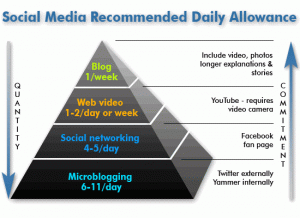In my post on the SMUG Social Media Pyramid and the follow-up on servings and portion sizes, I recommended a basic level of each of the four basic social media “food groups” which are represented in this graphic submitted by Valeri Gungor (click to enlarge):
This led to some interesting discussion in the comments, which deserves fuller attention. Here were some of the themes:
- Isn’t this just a “maintenance” plan? If you really want your social media influence to grow, shouldn’t you be beefing up with a lot more than what’s recommended here? Or on the other extreme…
- Doesn’t 6-11 servings a day of Twitter encourage the kind of inane celebrity updates on personal minute-by-minute activities that give Twitter a bad name?
- This seems like a tool-centric tactical approach, not a strategic tailoring of the tools to the particular objectives of the organization’s social media program.
So here’s some amplification of what a “serving” means.
To qualify as a serving your tweet, status update, video or blog post needs to…serve. Others, not just you. Any “servings” that don’t serve are actually subtracted from your total…they’re the social media equivalent of what Mom used to call “empty calories.” No nutritional value whatsoever.
In the food pyramid a serving is something you consume. In the Social Media Pyramid a serving is something you produce. It has to be of value to others to qualify. Otherwise it’s a negative. Five good tweets plus two pointless, self-promotional or “spammy” ones gives you a net of three servings, not seven. And some might even say a bad tweet is worth -2.
So in answer to the first two questions, I would say that the more real, valuable servings you provide, the more your influence will grow. And the more garbage you post, the more likely your Twitter followers leave, your Facebook friends and fans bail on you and you lose subscribers to your YouTube videos or your blog posts.
The third point, about strategy vs. tool-time tactics, I’ll tackle in the next post. And maybe I’ll expand on the serving scoring system.
Does this “net servings” guide make sense to you? How would you change it?

This is about as close to a perfect social media RDA as possible.
I thing the servings are just about right for most hospitals and other facilities – in fact for almost any industry or individual. This is a pretty healthy way to maintain good “web presence hygiene”.
The only food item is: consumption. How much to spend consuming other content? Also: commenting and replying and otherwise interacting: these may be things that don’t have a general rule, although having a presence beyond your own social graph is probably an important component of a healthy diet.
This is a great model, Lee – I shall have to tweet this!
@PhilBaumann
Lee! I love this model. This is great. I think we need more people on staff!
Great work Lee – really illustrates how to cover your social media bases
I like this, Lee! Great SoMe starter diet with lots of future metaphor/simile potential.
As for the goal of providing service in every serving, you are spot on. Before most of us can qualify any initiative as service, we have to be clear on our intentions. That’s ROI, “Return on Intention.”
I’ll add that while it’s okay to sell/promote/pitch, make sure you aren’t hiding behind cute packaging and messaging. Stepping out and selling or sharing transparently is preferred. Consumers are more than willing to receive a message (even bad news) when the context of the message is real and transparent.
I’ll be keeping this in mind.
Thanks for all your comments. I agree, Phil, that there is a “consumption” element needed, and reading and commenting on other blogs is an important activity for overall social media health. Gotta bring in ideas from outside and react to them. And writing a post about something you read on another blog, and linking to the original post, is a great way to help spread the conversation.
Isn’t microblogging the same as social networking? I might find a way to differentiate the two bottom layers of the pyramid. Bottom might be conversation and engagement. Further up might be curation on digital properties. Then continue up to content creation at the top, the most time consuming piece of what we do.
Thanks…yes, microblogging via Twitter is certainly social networking, and the differentiation you suggest on the bottom two layers is a valid one. Maybe I’ll do a Pyramid 2.0 looking at a different perspective. My main goal was to emphasize that there are easy “snacky” ways to be involved, as well as the more substantive and time-consuming content creation via video and blogging. You’ve got me thinking…. thanks for that!